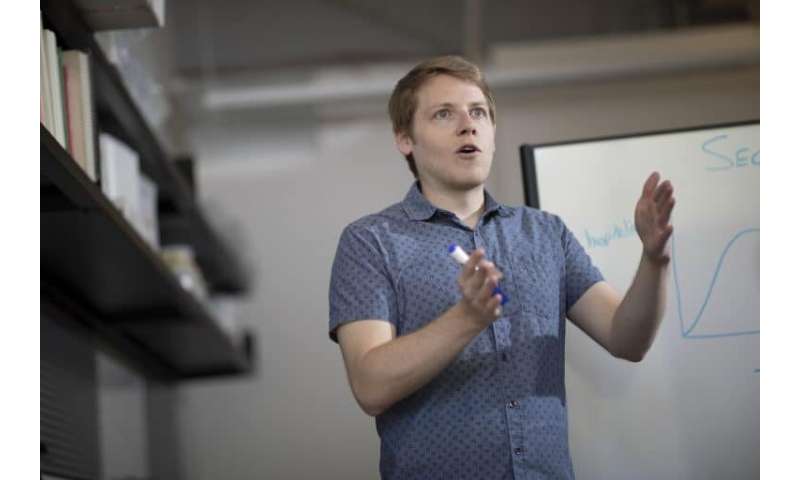
Joe Mihaljevic, a mathematical epidemiologist and assistant professor in Northern Arizona University’s School of Informatics, Computing, and Cyber Systems (SICCS), is leading a new project to create computer modeling systems to predict outcomes of the spread of the SARS-CoV-2 virus, which causes COVID-19, across four northern Arizona counties—Coconino, Navajo, Apache and Mohave.
Earlier this spring, Flagstaff Medical Center expressed an urgent need to model the spread of the virus for emergency planning and for requesting adequate resources from state and federal authorities.
“Reliable near-real-time transmission forecasting cyberinfrastructures are therefore vital for ensuring effective, equitable healthcare for Arizona’s rural populations during this pandemic crisis,” Mihaljevic said.
In March, the National Science Foundation (NSF) put out an urgent call to researchers in light of the emergence and spread of COVID-19, encouraging scientists to use the Rapid Response Research (RAPID) funding mechanism to support virus-related research. Mihaljevic applied for and received a $200,000 one-year grant to develop a disease modeling portal in collaboration with computer scientist and SICCS professor Eck Doerry and evolutionary biologist and SICCS assistant professor Crystal Hepp, an assistant director of NAU’s Pathogen and Microbiome Institute. The collaboration brings together three key areas of expertise: Mihaljevic is a disease modeler; Doerry transforms novel ideas into highly usable software solutions; and Hepp is an evolutionary biologist who focuses on RNA virus spread and public health data analytics.
Using a secure interactive web-based modeling portal that Doerry developed, Mihaljevic can draw in the latest reported case data from local health authorities and run live models in an interactive interface that decision-makers can use to explore possible scenarios and projected outcomes.
“In all four counties, the pathogen is moderately under control, although there is regional variability, with some populations more at risk,” Mihaljevic said. “We are slowing the virus, but now we want to understand what will happen if we start to remove the interventions in place, like social and physical distancing. You might have heard we’ve reached the peak. In disease outbreaks, there can be multiple peaks. Easing restrictions too soon can mean multiple lockdowns.”
For example, if all restrictions were removed in early May following 45 days of stay-at-home orders, his model predicts a second peak with at least three times the number of hospital visits than the current rate.
“We could see upwards of 100 new hospital visits per day,” he said.
If distancing measures are maintained until May 31, on the other hand, the model projects a smaller second outbreak when restrictions are removed.
“With 75 days of interventions in place, a second peak in northern Arizona could be a bit smaller than the first peak, in an optimistic scenario,” Mihaljevic said.
“In short, many of the current models developed to manage the COVID-19 crisis are likely not completely adequate to describe pathogen spread in rural regions. We have urban centers like Flagstaff that are really nested in a more rural landscape—a metapopulation, if you will—with communities that are very different from one another. We will be able to track the number of patients being sent to which hospitals and understand which facilities are most stressed,” Mihaljevic said.
The computer model is based on disease surveillance data, data from the U.S. Census Bureau and medical center information tracking how many hospital beds are available in each county. Mihaljevic says part of the grant is to develop fine-grained mapping.
“Let’s say you’re a hospital and you want to understand what’s going on in your region. You will be able to filter the data and projections just to your county or hospital system.”
Hepp collaborates with a variety of public health partners in her research.
“With a strong understanding of the types of data available in public health reporting systems, coupled with an awareness of data sensitivity, my contribution is to help identify which data are needed to go into the computer model,” Mihaljevic said. “We don’t need private information like a patient’s name or address, but we can aggregate numbers to inform the model based on information such as ZIP codes, when a person first started feeling sick and when a nasal swab was taken to test for the disease.
“Our goal is to develop a cyberinfrastructure, a web application to help us communicate the results of our modeling to public health and healthcare stakeholders who can visually interact with the model and manipulate the parameters to explore these scenarios and make informed decisions for a data-driven public health plan.”
Mihaljevic believes his computer modeling also will help inform elected officials about how and when to remove physical distancing restrictions and re-open businesses and public spaces.
Source: Read Full Article
